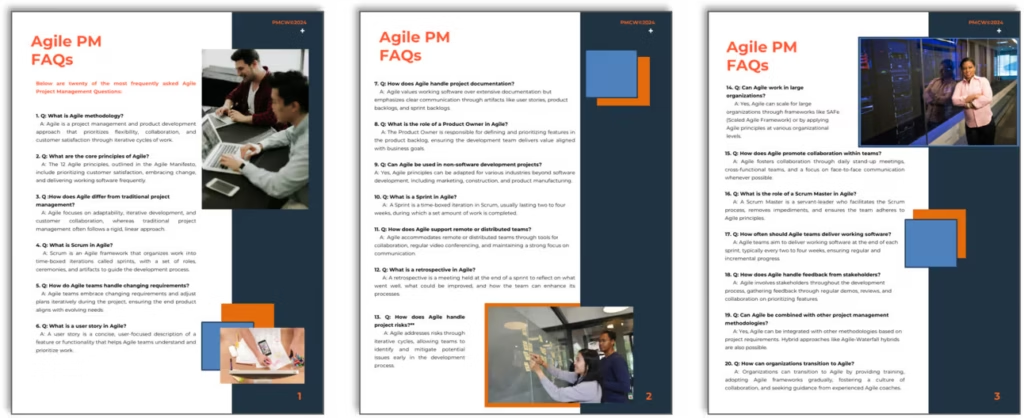
Understanding the distinctions between Agile and traditional approaches is crucial for professionals navigating the complexities of project delivery. In fact any opportunity to grow your knowledge of project applications and methodologies will support your development within the profession.
Start by downloading a free Agile Project Methodology FAQ Sheet, to ensure you understand the foundations:

So let’s continue our tour through the Agile project delivery methodology.
Agile remains a popular approach for project delivery, and as we explained in last week’s article, it is based on a set of twelve basic principles. You can read that article here, if you missed it. And keep reading for an explanation of how the streaming service Spotify used Agile to get ahead of its competition.
Old versus New Ways of Doing Things
Implementing traditional project management methods over Agile approaches can be a strategic choice based on the nature of the project and organizational requirements.
Traditional project management, with its structured and sequential approach, may be preferable in situations where project scope, requirements, and timelines are well-defined and unlikely to undergo significant changes.
Industries with strict regulatory compliance or projects with fixed contractual obligations may find traditional methods more suitable for ensuring strict adherence to predefined plans. Additionally, projects with a clear, linear path and minimal need for continuous adaptation might benefit from the predictability and stability offered by traditional project management.
Traditional project management often operates within rigid structures and fixed plans. Whilst Agile’s iterative nature and adaptive mindset provides an unmatched flexibility, which many consider to be more aligned to today’s dynamic business landscape.
So you are able to make the right choice for when to implement an Agile-based approach over more traditional methods.
Here are some of the other criteria that you should consider:
Rigid Structures vs. Flexibility:
Traditional project management often relies on rigid, linear structures, emphasizing detailed upfront planning. Projects are meticulously mapped out from start to finish in a sequential fashion. While this approach can offer a sense of predictability, it can also become a hindrance when faced with unforeseen changes or evolving requirements.
Agile Approach: Agile, on the other hand, embraces flexibility and adaptability. It acknowledges that change is inevitable and, instead of resisting it, integrates changes seamlessly throughout the project. Agile operates in iterative cycles, allowing for continuous adjustments and enhancements based on ongoing feedback. This approach ensures that the project stays responsive to evolving needs, providing a distinct advantage in dynamic business environments.
Fixed Plans vs. Iterative Progress:
Traditional project management often involves creating detailed project plans at the outset, with little room for deviations. The entire project is outlined in advance, and any changes can be cumbersome and costly, leading to potential delays.
Agile Approach: Agile thrives on iterative progress. Instead of locking in plans at the beginning, Agile divides the project into smaller, manageable iterations or sprints. Each iteration results in a potentially shippable product increment, allowing for continuous evaluation and adaptation. This iterative nature enables teams to respond swiftly to changing requirements, ensuring that the project remains aligned with evolving business objectives.
Spotify’s Agile Symphony:
Spotify, the music streaming giant, orchestrated its success using Agile methodologies. From cross-functional teams to the concept of “squads,” Spotify’s Agile implementation allowed for rapid innovation, efficient communication, and the delivery of features that resonated with users. Spotify even created a unique “Spotify Model” for scaling Agile.
Embracing Change as a Constant:
Traditional project management may view changes as disruptions to the original plan, potentially causing resistance among team members. Change is often treated as an exception rather than a constant reality.
Agile Approach: Agile, in contrast, embraces change as a natural and expected part of the process. Agile methodologies welcome evolving requirements, understanding that they provide opportunities for improvement and innovation. By making change a constant, Agile ensures that the project remains dynamic and responsive to the ever-shifting demands of the business landscape.
Customer Collaboration throughout vs. Fixed Customer Interaction Points:
Traditional project management often involves limited customer interaction, with designated points for feedback and evaluation. This can result in projects that may not fully meet customer expectations.
Agile Approach: Agile prioritizes continuous customer collaboration throughout the project. Regular feedback loops and open communication channels ensure that customers are actively involved in shaping the evolving product. This approach not only enhances customer satisfaction but also allows for swift adjustments based on real-time insights.
Predictability vs. Adaptability:
Traditional project management seeks predictability, aiming to adhere to the original plan and timeline. However, in today’s rapidly changing business environment, this predictability can sometimes lead to projects that are obsolete upon completion.
Agile Approach: Agile prioritizes adaptability over predictability. The iterative cycles allow teams to adapt to changing circumstances, emerging technologies, and shifting market conditions. This adaptability ensures that the end product remains relevant and valuable in an ever-evolving business landscape.
The Agile approach succeeds in breaking down the walls of traditional project management by fostering flexibility, adaptability, and continuous collaboration. As professionals, embracing Agile methodologies equips project managers with the tools needed to thrive in the face of uncertainty, navigate changing requirements, and deliver high-value products that resonate with both stakeholders and end-users alike.
While Agile excels in dynamic, uncertain environments, traditional methods can provide a sense of control and certainty that aligns well with specific project demands and organizational preferences. Ultimately, the choice between Agile and traditional project management should be driven by a careful assessment of project characteristics, stakeholder expectations, and the overarching goals of the organization.
Choose wisely my friend!
Wishing you another week of growth, development and project enlightenment!
Swanwick House, 22 Towcester Road, Old Stratford, Milton Keynes, MK19 6AQ, UK
© 2025 Project Management Global. All rights reserved | Privacy Policy